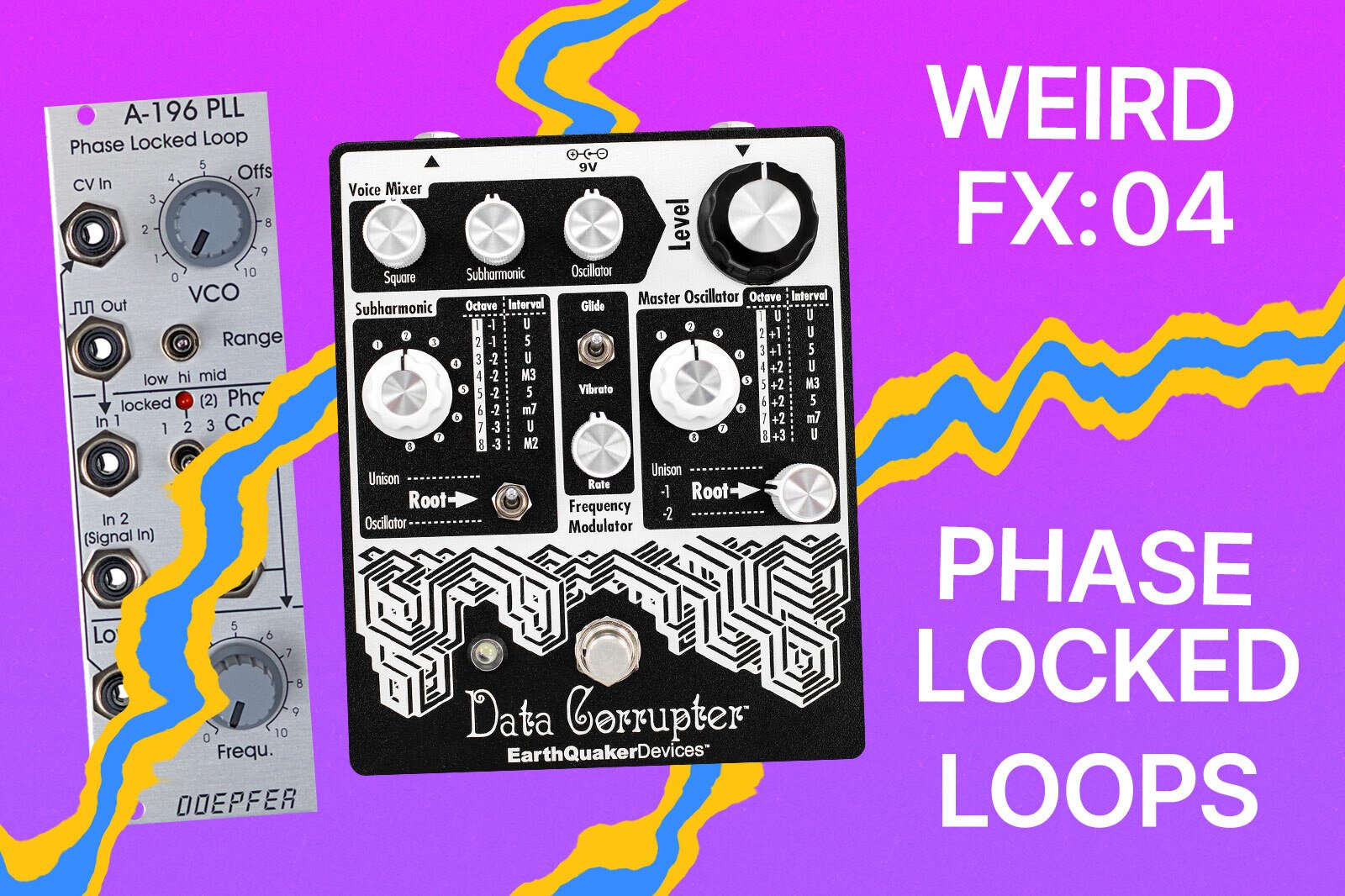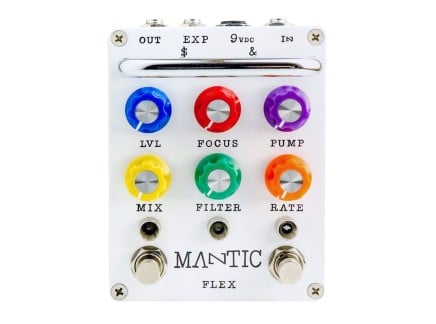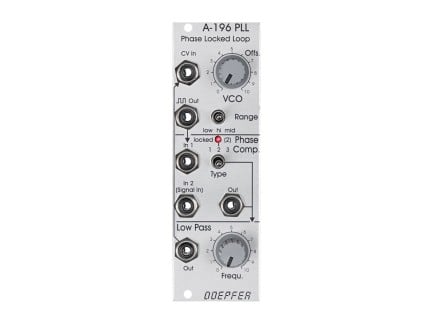Processing sounds through effects bears a certain special appeal that may be difficult to understand to those who take the most pleasure in the natural, unaltered tone of acoustic instruments. Not that one is better than the other—both approaches to working with and appreciating sound deserve respect and attention, but for the sake of this article we are primarily interested in the modification of sound, and the more radical the better.
Those who share our fascination with various methods of sound processing (perhaps you?), will certainly know the feeling of untamable curiosity about what will come out of the speakers once we pass a familiar sound through a circuit/algorithm and turn a few knobs. While certain effects tend to yield relatively predictable results, there are also those that never cease to surprise—somehow turning every interaction into a sonic experiment. This can be particularly interesting: not knowing exactly what we will hear can be incredibly fascinating. With the right device, it is possible to spend hours (or days) turning knobs just to hear as many sonic outcomes as possible.
Today, we continue our Weird FX series with one particularly odd type of audio processing tool known as a Phase-Locked Loop, or PLL for short—a strange sonic mangler somewhere between a fuzz, a pitch-tracking synth/harmonizer, and a chaotic noisemaker.
So What Is A Phase-Locked Loop?
Generally speaking, a phase-locked loop is a special type of synchronization system where the phase of an output signal is related to the phase of the input signal. We're going to focus on the application of such a system in the context of sound synthesis and audio processing, but phase-locked loops and similar synchronization systems are not only only part of man-made applications—they also exist as natural phenomena.
"Synchronization" implies that several separate and potentially unrelated events start operating in unison with each other. It appears as if we, humans, are preprogrammed to interpret synchronous processes in a chaotic universe as the oases of order. While we won't even try to answer the question of why all such patterns exist, we would like to point out that, in fact, many things in the natural world exhibit attraction towards synchrony. Some of the most common examples of that are spontaneous synchronization of clapping of a large audience, flashing of fireflies species in Southeast Asia, rotational motifs of planets and moons, flocks of birds, groups of fish performing unfathomable dances, and so much more. This is also true for even the most basic inanimate objects, like clocks and pendulums.
To illustrate this let's turn to the famous synchronized metronome experiment that many should be familiar with. In that experiment, any number of metronomes (it just has to be more than one) are placed on a light support board which is in turn positioned on top of two bottles (or any other similarly loose/rolling object). The idea here is that the platform should be light and moveable enough to be affected by the natural motion of the majority of the metronomes—this is known as weak coupling. Then all metronomes are started at different tempos, and after a short while, we can witness that all metronomes start to synchronize to the tempo of the majority. This happens because the mechanical vibration coming from the motion of the majority of metronomes gets transferred by the platform to the rest of the metronomes, eventually aligning their phases, and forcing them to sync. And while there are many methods, strategies, and rules of synchronization...the metronome example perhaps can be seen as abstractly representing a rudimentary natural PLL.
In the context of a circuit or an algorithm, a simple phase-locked loop system consists of a phase comparator, a voltage-controlled oscillator, and a low pass filter. To put it in context—an input signal enters a phase comparator (we will discuss what this is later in the article), then passes through a filter into the frequency control input of the VCO, whose output is both sent out from the circuit and also fed back into the second phase comparator input. As a result, the VCO attempts to synchronize with the frequency of the input signal.
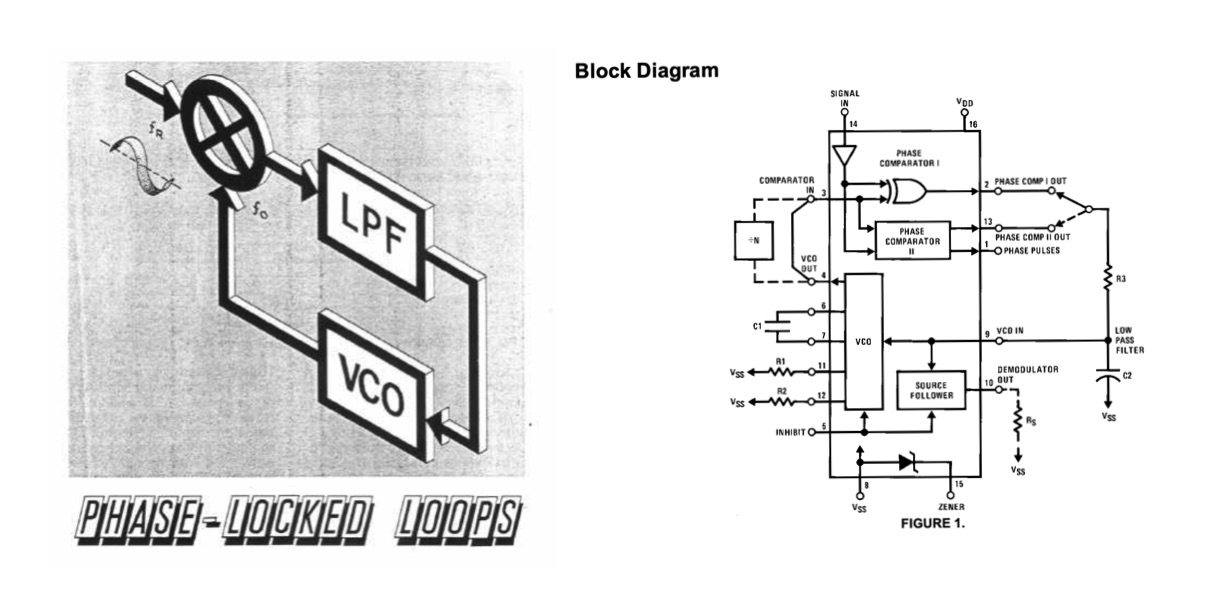
The applications of phase-locked loop systems are vast, and it is likely that you are currently surrounded by PLL circuits of various complexities—as they are used in radio, television, cell phone, and computer technologies. One of their most common applications is clock synchronization between circuits, jitter reduction, and frequency synthesis (not the kind of synthesis we usually talk about here, and thus we move forward).
When we use PLLs as audio processors, we scale the frequency range of the oscillators to the range of our hearing. The most common application of a phase-locked loops in electronic music is to create synth-like pitch-tracking effects. It is important to note an important theme before we go further: the output signal of a PLL is by nature imperfect...and in fact, its sonic wildness has a unique charm, and is best seen as a feature rather than a bug. Depending on the device used, the range of sounds one can get from a PLL-type effect can range from rough bit-crushed tones reminiscent of sounds in '80s computer games to aggressive fuzz/distortion...or from clean sync-like synth leads to unruly noise. One thing is for sure, though—phase-locked loop processing is never subtle.
History & the Schumann PLL
 A modern reimagining of Buchla's 232 Frequency Detector
A modern reimagining of Buchla's 232 Frequency Detector
While there is plenty of information on phase-locked loops in general—what they are, circuit diagrams, usage in various fields—the earliest applications of such circuits in musical context remains largely a mystery. We know that these devices were used by countless sonic tinkerers in the early days of electronic music (David Tudor, for instance, is known to have used PLL-based instruments built from kits)...but establishing an early history of these devices' intentional use as devastating noisemakers is unclear. One of the first commercially-developed (albeit very rare) musical devices that we can trace the implementation of PLL to is the Buchla 232 Frequency Detector module, which was developed specifically for translating dynamics and pitch of an acoustic/electric instrument to control voltage for interaction with the synthesizer. It is one of the earliest applications of audio-controlled synthesis, discussed in greater depth in this article.
Perhaps one of the most significant events that started driving the creation of more and more musical devices based around the phase-locked loop was the introduction of a commercially available PLL chip in CMOS format: the 4046. In fact, some versions of the aforementioned 232 Frequency Detector module were built with the 4046 chip (an image from whose datasheet can be seen above), and moreover, given its ease of implementation and widespread availability the vast majority of PLL sound manglers were (and still are) based on that very same chip.
One of the most renowned phase-locked loop devices designed specifically for processing sounds was the Schumann Electronics PLL—and in fact, we can look to it as the touchstone that began the craze of pedal-format PLL-based sound mangling devices. Created in the early 2000s by New York boutique pedal builder John Schumann, the Schumann PLL quickly gained a cult following for its outlandish tonal potential, and it started appearing in the arsenals of popular bands like Radiohead, Portishead, Sparklehorse, the Locust, and many others. Interest in the pedal was very much justified, since at the time there really was no other effect that offered sonically what the PLL did. One could tune it to convert the guitar signal into a synth sound with three-part harmony, squeeze some of the nastiest fuzz tones out of it, or with a few tweaks, take it into even more extreme and noise-ridden territory. This was part of John Schumann's philosophy in building pedals: he wanted extremes to be available to musicians, which meant that players could have more control of the sound...but at the same time, if they didn't know how to use the thing, it was quite possible to blow up an amplifier.
The knob-laden Schumann PLL was an oddity for its era, with a panel densely populated with controls. Indeed, deciding on which parameters to make accessible to the user was one of the reasons it took John about two years to design the pedal. As he stated in his Tape Op interview, he could've easily put around 50 controls on it—but of course, that would've made it practically impenetrable by the majority of guitar players, so he took time to decide which parameters were the most engaging and essential.
The other aspect of the design that extended the development time was related to tuning the circuit to respond well to guitar signals, which are quite unpredictable/inconsistent by nature. PLLs play quite well when using the steady waveforms of oscillators as inputs, but vibrating strings (especially note release) are mischievous, constantly changing in harmonic structure...and as such, PLLs struggle to follow them, which can often result in strange vibratos (at longer response times) and a plethora of other weird sonic artifacts depending on the settings. Of course, many musicians and producers quickly became interested in trying all sorts of sound sources with Schumann PLL, and each one delivered a unique response. For example, running a drum machine through a PLL would result in an automatic bass line from the pedal with plenty of character and variance. Using it with vocals unveils yet another realm of peculiar effects.
Controls on the Schumann PLL
Without a doubt, the Schumann PLL became a staple and a primary influence on many future effects exploring the possibilities of a phase-locked loop in audio. Thus, let's briefly take a look at the control structure and signal flow that Jonathan settled on for the pedal. Once we've seen how the Schumann PLL works, we'll have a template for understanding other modern PLL effects out in the wild.
Once a signal enters the Schumann PLL, it goes through the Preamp stage for amplification, and then the "Trigger" stage, which converts it into a square wave. The square wave then passes to the PLL portion of the circuit, locking onto to the frequency of the input source. The interaction between the input signal and the oscillator can be adjusted with a Loop Speed switch, as well as Lag Time, Response, and Loop Track controls. The oscillator is further passed through a frequency multiplier and divider for harmonization, allowing access to notes within the harmonic and subharmonic series. Both the divider and multiplier sections feature phase polarity switches. The square wave, multiplier, and divider have dedicated volume knobs, allowing for custom balancing between three sources. Finally, there are also Waveshape and Master level controls.
It is important to note how interdependent controls on the PLL are: changing one parameter does not only alter that particular aspect of the effect, but also influences the response of other parameters, often quite radically. This makes it somewhat difficult to predict, and dialing in the same tone twice might take some time and experience. John Schumann also added a couple of accessory sockets to the PLL—one for PLL Drone (an add-on for creating continuous oscillation), and a 5-pin DIN MIDI input labeled Arpeggiator for a planned companion sequencer...which (as far as we know) was never publicly released.
As we have mentioned, Schumann's PLL was such a groundbreaking release that it became "The PLL" to inspire the majority of future phase-locked loop effects boxes. Since it was also released in quite a limited number of copies, it is extremely rare—and the prices of second-hand originals have skyrocketed. Thus, a few savvy pedal builders have been inspired to release "clone" versions of Schumann PLL. Among such devices were Elta Music's PLL-4046, the Dimehead PLL, and Ftelettronica Schumann PLL...but there are now several other pedals out there that offer their own spin on this odd effect.
Modern PLL Pedals
Earthquaker's Data Corrupter takes direct inspiration from the Schumann PLL (and the Electrax Synthax and the “Basic Frequency Synthesizer” by Ray Marston, for that matter), but offers a simplified user interface that makes it easier to dial things in while still offering a huge range of sounds from synth basses to harmonized leads and just outright destructive noise, clicks, and dive bombs. It features three potential sound sources with a dedicated per-source mixer and output level control—these three sources are labeled Square, Subharmonic, and Oscillator. The Square signal is a square wave fuzzed-out version of your input...much like a typical fuzz, albeit quite aggressive and with no tone controls aside from volume. This squared-up signal is used to feed the PLL and subsequent divider/multiplier circuits—the Subharmonic and Master Oscillator sections, respectively. Each of these sections features an eight-position switch that determines their tuning: the Master Oscillator produces pitch shifts that correspond for the first eight partials of the harmonic series (with an optional down-shift of one or two octaves), while the Subharmonic section produces subharmonics ranging from the second to ninth partials. Furthermore, while the Master Oscillator's pitch is always defined relative to your input signal, the Subharmonic section can either track your input or the Master Oscillator—allowing everything from enormous stacked octaves and wide harmonies to tighter, close voicings. Between the three sound sources, you can dial in a huge range of intervals both consonant and dissonant.
Data Corrupter's Frequency Modulator section has two modes: Glide and Vibrato, each of which impart a special effect on the pitch of the Master Oscillator with variable rate control. Vibrato can be used to dial in everything from wide, slower modulation to exaggerated theremin-like vibrato effects, while Glide allows fine-tuned control of the oscillator's glide between notes. This isn't quite the same thing as glide or portamento on a synthesizer...while it does affect note-by-note pitch changes, it most obviously controls the length of the "dive bomb" effect—the not-so-subtle huge pitch sweep that happens when your instrument goes from making sound to being silent. We'll discuss the dive bomb sound a bit more later. Our biggest takeaways about the Data Corrupter? It's a ridiculously fun, amazing-sounding PLL that gives you all the skronk and mayhem you could want, while making it surprisingly easy to dial in relatively stable tones and harmonies if you want them.
Then there are still other PLLs that try to deviate from Schumann's original design without sacrificing the wild and unpredictable nature of the effect—and two of our favorites are Glou Glou's Moutarde, and Mantic's Flex Pro.
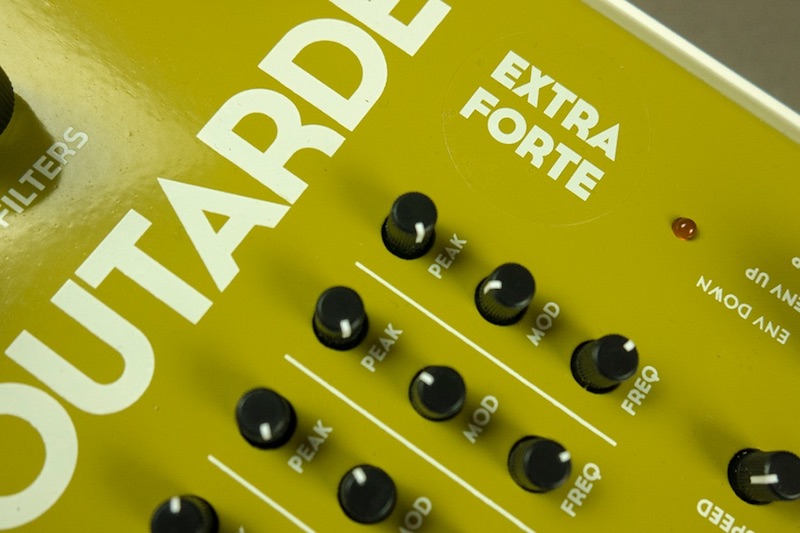 Detail of the Moutarde Extra Forte
Detail of the Moutarde Extra Forte
The Glou-Glou Moutarde Extra Forte is a large-sized effects box with a distinct shape and a bright green color. The stompbox is not only a phase-locked loop, but rather a multi-effects unit featuring a bank of four low-pass filters, a gated fuzz, a four-voice PLL harmonizer, and internal modulation capabilities. Each of the filters in the Moutarde has a dedicated control over cutoff frequency, resonance, and the amount of modulation, allowing the users to dial in unique evolving tones. The modulation sources include an LFO, a regular and inverted envelope follower, as well as an external Expression input source. The PLL section can be altered by a set of transposition presets that run from consonant octaves and fifths to "jazzy" 9th and dominant chords. The tracking of single-line melodies is impeccable on Moutarde unless a user specifically wishes to impart more glitches into the playing—for that, they can adjust the Sensitivity (of the pitch-tracking) parameter. And of course, as with any PLL, once you start to play chords, the fuzzy mayhem is unavoidable.
Mantic's Flex Pro is another modern classic PLL aimed at the chaotic end of the spectrum, featuring a seemingly more streamlined interface—yet within its relatively compact enclosure, it hosts a world of very unconventional sounds. If the weirder side of PLLs is what you are after, the Flex Pro might be just the right move. Speaking of the pedal's unique sonic potential, up to 24 different filter types can be accessed via a six-position rotary encoder and two two-position switches on top—cryptically labeled "$" and "&." It is also equipped with a built-in modulation LFO with a dedicated Bypass switch and an LED indicator for modulation rate. Sound-wise, Flex Pro offers a variety of sweeping, breaking apart, distorting, and glitching out tones that the extreme side of PLLs is known for, although with the right setting you can certainly get more tamed filtered square wave synth sounds.
PLLs in Eurorack
If you are looking for a straightforward PLL module in Eurorack then perhaps the best solution is the Doepfer A-196 module, designed specifically for the task in question. What is nice about the A-196 is that it offers three types of phase-comparison options for different sonic results, as well as the option to break the internal normalization with an external signal to replace the built-in VCO.
With all of the above said, given the openness of modular synthesis, the most flexible way to explore phase-locked loops in Eurorack is by building a custom patch using simple building blocks. Following the recipe described at the beginning of this article, it is possible to create phase-locked loop patches of varied complexities. Remember, for a basic system all we need is a voltage-controlled oscillator (or two if you would like your input source to be another oscillator), a filter, and a phase comparator. It feels safe to assume that the first two ingredients don't necessarily need an explanation, although it is worth mentioning that the filter doesn't have to be fancy or resonant, and actually, something like a slew limiter or an integrator would be enough to make things work, so you can use the Slew inputs on your Make Noise Maths or Function modules, or perhaps Doepfer A-170.
Now let's talk a little about what can be used for phase comparison. A few different types of modules designed to compare two signals in various ways could be employed here. These include bipolar VCAs like Mutable Instruments Blinds, ring modulators such as Make Noise modDemix, and XOR logic as in Mystic Circuits Ana. It is quite important to note here that different types of phase comparators will significantly alter the timbral quality of the output. Once you have the basics in place, you can start adding more things into the equation such as frequency dividers, multipliers, and waveshapers. Really from that point on, experimenting is the best strategy—you'll no doubt stumble across an enormous array of ungodly and terrifying tones in no time.
Taming the Beast: PLLs in Practice
So we've explained some of the sorts of things you might want to do with a PLL effect—and while they are an excellent place to look for general sonic chaos, we find they can also just be an excellent way to replace synth parts by using guitar or other instruments. By substituting conventional synth parts with a PLL, you can shake things up a bit...adding instabilities and nonlinearities that keyboard synths are often designed to avoid. This type of sonic character, even when exploited only subtly, can add a ton of nuance and life to your sound. Of course, getting a PLL to behave predictably can be a bit tricky, and getting its raw, bright, abrasive output to fit into a mix can also be a challenge. As such, here are a few tips for getting a PLL to play nicely specifically with a guitar or bass. (Oh, and a quick note: our accompanying audio examples were created using a Data Corrupter!)
First things first: PLLs produce the cleanest results when processing monophonic sounds. Playing single-note melodies is a good first step toward getting cleaner, more consistent PLL sounds; open fifths or other simple harmonies can be okay, but once you start playing chords, things get considerably less predictable. So, one of our strongest bits of advice hinges around something we mentioned before: PLLs are actually fairly stable when locked on to clean, repeating waveforms like those in a typical synthesizer...they gain their chaotic, idiosyncratic character when processing sounds with constantly-varying timbre. Of course, guitar is one such device; from the time you pluck a note until the time it decays, the actual waveform the instrument produces is constantly changing. There's a lot you can do to control this, though! For one, adopting a precise playing technique can make a big difference: by ensuring that your picking dynamics are completely consistent, ensuring that there's no fret buzz, and by ensuring that your transitions between notes are quick and precise, you can get to much more predictable sounds.
Of course, physical playing technique aside, there's a lot you can do to condition your guitar's sound to work nicely for PLL processing. The first suggestion here has to do with tone: generally speaking, smoother, darker waveshapes will offer greater consistency, helping the PLL to lock into your sound's fundamental frequency rather that some dominant overtone (or constantly shifting overtones). On guitar or bass, we suggest using your instrument's neck pickup and rolling back your tone control to darken up your sound before hitting the PLL. The guitar we used for our audio demos in this article was a Fender Jazzmaster—by using the Jazzmaster's rhythm circuit, we were able to dial in a super dark, round sound that helped the Data Corrupter to track pretty dang well. Using a lowpass filter between your instrument and a PLL can also be helpful—but beware adding resonance to your filtered sound, as it'll take you into even crazier territory.
If you've tuned your instrument's tone to be as dark as it can get and you're still having problems with unpredictable pitch "glitches" at the beginnings of notes, try adjusting where you're picking relative to your pickups. It's a bit peculiar, but we find that picking on the neck around the 12th to 15th frets can help remove a lot of the noise from your attack, giving the PLL something more immediately "tonal" to grab onto. From there, if your instrument's sound is decaying quickly in such a way that the PLL pitch starts to become unstable durning sustained notes, you can try any number of sustaining techniques: a simple compressor can go a long way in evening out your note attack and decay, but less traditional approaches like Ebows or other sustainers can go a long way as well.
Of course, the peculiar tracking is only one of the difficulties in taming a PLL: even once you've got it cleanly tracking, the tone itself can be quite abrasive. As synthesists, one solution to taming the PLL's tone is fairly obvious to us: filter it! By adding a filter post-PLL, you can get even closer to achieving a synth-like tone. By using an envelope filter, you can additionally accentuate the sound's natural dynamic contour, not unlike using envelopes on a synthesizer...and of course, as the sound dive bombs into low-frequency clicks, you'll get added wet plops and pinged resonances.
That brings us to another point: how can you tame the dive bombs? This is another question of playing technique: by carefully controlling your notes' endings and dialing in your preferred glide time, you can determine how much dive bomb there is and when it happens. You can go quite far playing palm muted, varying the pressure of your muting in order to change the PLL timbre and note decay. Using palm muting can be a great way to add timbral variation—switching between unmuted and muted picking techniques can be the difference between a nasal Justin Pearson-esque bass line and a rich, full synth harmony.
As with any weird effect, the most important thing to remember is to experiment: try out some sub-bass rhythmic clicks, snarling bass lines, theremin-like pitch sweeps, or blastingly loud, edgy-sounding harmonies. There are a huge range of timbres hiding here, and no rules about how to use them.
Looping Back
We've now reached the last part of our conversation about the phase-locked loops, at least for this time. As the principle of synchronization is not particularly new, and as you've seen earlier in the article, there is plenty of evidence of its natural origin and tendencies, the application of phase-locked loop systems in audio is far from being overexplored, and there is plenty of potential for further experimentation. So enjoy exploring the PLLs—and we are off to prepare the next edition of Weird FX for you.
Schumann PLL images via audiofanzine.com and blackbookguitars.com

